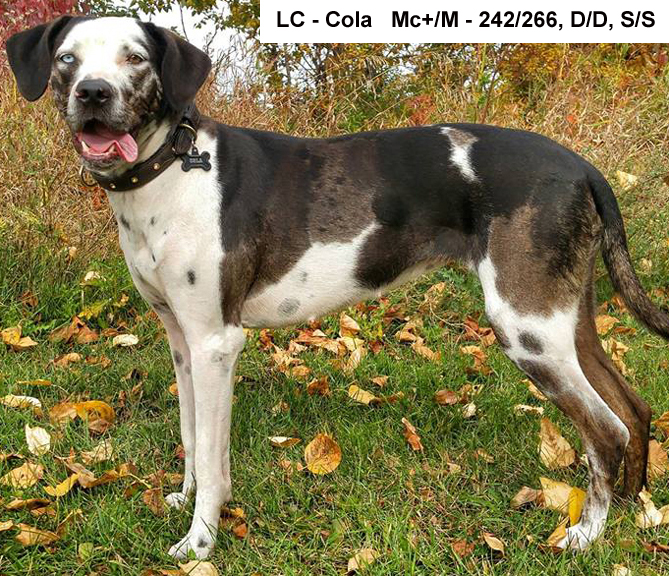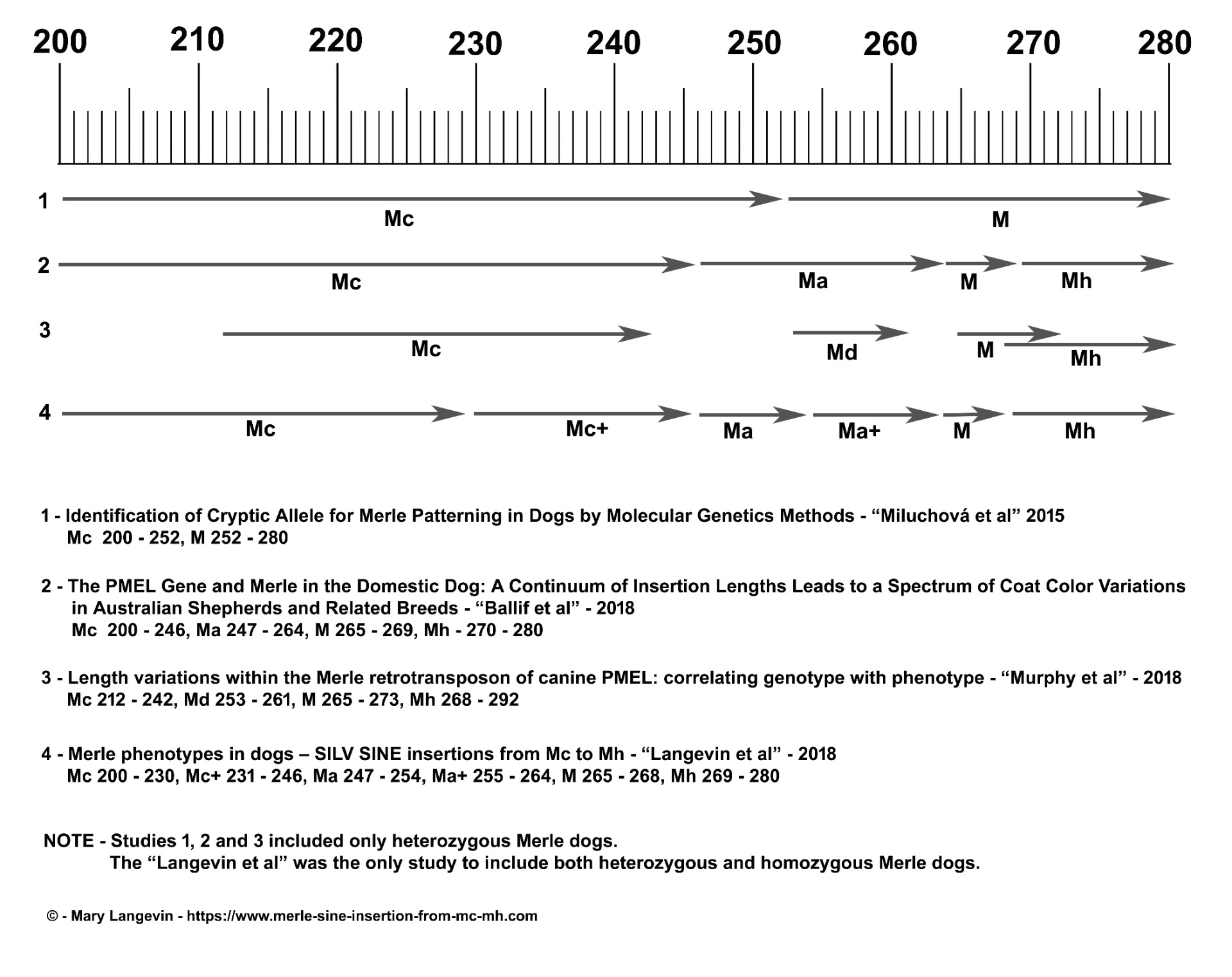Downloadable PDF of this article. This PDF can be freely shared :o)
Defining The Scale Of Merle
The following chart shows the comparison allele lengths from 4 different published papers.
#1 - scale includes only 2 alleles, Mc and M, from a paper published in 2015, "Milushova et al". The length of the two alleles was set using the old testing method and based on phenotype. Dogs 252 bp and below were most likely to express no Merle pattern. Those 253 and above either had a noticeable Merle pattern or where starting to show signs of an unusual coat shading or faint pattern.
#2 - scale as set by Paw Print Genetics "Ballif et al" including 4 alleles, Mc, Ma, M and Mh based on phenotype, with Ma starting at 247 bp which was a number already set by Biofocus with the help of Dr. Helena Synková in 2011. This leaves the Mc extending as far as 246 bp.
#3 - scale from the "Murphy et al" (Dr Clark) paper including 4 alleles with Md (equivalent to Ma) starting at the same number as scale #1's M allele of 253 bp based on phenotype. This leaves a gap between Mc and Ma with Mc possibly extending to 252 bp. M and Mh overlap. NOTE - this paper uses T length numbers, I have converted them to base pairs for easier comparison.
#4 - scale as defined by "langevin et al" with 6 alleles - Mc, Mc+, Ma, Ma+, M and Mh
The two distinct differences between scale 1, 2 and 3 when compared with the "langevin et al" scale is that 4 is based on phenotype AND breeding results. These breeding results include HOMOZYGOUS results. Scale 1, 2 and 3 have only included heterozygous dogs in their research. Given that Merle is an incomplete dominant this is a very important distinction which is explained and demonstrated in more detail.
Murphy et al
"Length variations within the Merle retrotransposon of canine PMEL: correlating genotype with phenotype."
Sarah C. Murphy, Jacquelyn M. Evans, Kate L. Tsai and Leigh Anne Clark Received - June, 5, 2018; Accepted - July, 27, 2018;
Published - Aug, 3, 2018
Murphy et al. Mobile DNA (2018) 9:26 https://doi.org/10.1186/s13100-018-0131-6
#1 - Base Pair Ranges
"Base pair ranges that correspond to the four varieties of the merle phenotype: cryptic (212 - 242 bp), dilute (253 - 261 bp), standard (265 - 273 bp), and harlequin (268 - 292 bp)."
Note the lengths are not a continuum - there are gaps between cryptic/dilute and dilute/standard. Their "harlequin" phenotype overlaps their "standard" phenotype. We did find a clear border between M and Mh.
Their "dilute" phenotype starts at 253 bp which compares to the lower end of our Ma+ allele. No difference in phenotype was noted under 253 bp which encompasses our Mc, Mc+ and Ma alleles. The expression of these 3 shorter alleles can appear very similar as heterozygous however as homozygous combinations they can create clear phenotypical differences. Since all 259 dogs in the Murphy et al paper were heterozygous for Merle there was no ability to compare base pair ranges as homozygous combinations or any combination with other length alleles. Being that Merle is an incomplete dominant this is a very important distinction.
m/Mc, m/Mc+, m/Ma - Heterozygous
Mc/Mc, Mc+/Mc+, Ma/Ma - Homozygous
Paw Print Genetics "Ballif et al"
"The PMEL Gene and Merle in the Domestic Dog: A Continuum of Insertion Lengths Leads to a Spectrum of Coat Color Variations in Australian Shepherds and Related Breeds"
Ballif BC, Ramirez CJ, Carl CR, Sundin K, Krug M, Zahand A, Shaffer LG, Flores-Smith H.
Paw Print Genetics, Genetic Veterinary Sciences, Inc., Spokane, WA , USA Received - April, 6, 2018; Accepted - June 4, 2018; Published - Aug. 3, 2018
Paw Print Genetics https://www.ncbi.nlm.nih.gov/pubmed/30071510 PMID: 30071510 DOI: 10.1159/000491408
There are two main issues I would like to address when comparing the "Paw Print Genetics" paper to "Langevin et al".
#1 - Base Pair Ranges
200 - 246 Cryptic - Most cases are non-merle but in rare cases may have very small merle patch(es) or subtle color anomalies.
247 - 264 Atypical - Most cases show a significant shift from normal coat color often giving a diluted color, show reddish undertones, or have an otherwise atypical merle appearance.
265 - 269 Classic - Most cases show classic merle with a significant amount of merle color and pattering, although some cases may only show a minimal amount of merle.
270 - 280 Harlequin Most cases display patches of multiple shades of the same or different colors without white (tweed) or with white (harlequin) and are often referred to as patchwork.
Their "Cryptic" bin of 200 - 246 bp includes both our Mc and Mc+ alleles, which can express different phenotypes when homozygous and also when inherited with different length alleles.

The Mc allele as set with the "langevin et al" scale at 230 bp will not delete pigment to white when combined with M. However when Mc+ is combined with M there is the possibility of pigment being deleted to white in the Merle pattern which some breed standards do not allow and could be a concern for impairments.
Cola is Mc+/M - 242/266 and has quite a bit of pigment deleted to white.
You will note that her Mc+ allele is 242 bp which falls into PPG's Cryptic bin.
Their "Atypical" bin of 247 - 264 bp includes both our Ma and Ma+ alleles, which can express very different phenotypes either as heterozygous or homozygous and also when combined with the M allele.
#2 - Cryptic and "small merle patch(es)" or subtle color anomalies.
m/Mc does not create any Merle pattern what-so-ever, nor any change to the coat color or shading. The expression of Minimal Merle "small merle patches" is well documented to be caused by two distinct Merle genotypes -
#1 - Mh - Harlequin Merle
#2 - mosaicism where the longer M allele has become the minor allele.
Unfortunately PPG tested this pup as m/Mc and came to the incorrect assumption that the Mc allele could cause "small merle patch(es)". In this case correlation does not imply causation as any researcher should understand. This pattern on the pup's ear is NOT minimal merle caused by the Mc allele. This phenotype is commonly seen in breeds where "Whitehead" is common and there is pigment deletion on the ear area. We have many examples of dogs tested as m/m Non-Merle with this same expression.
All these Australian Shepherds have tested as m/m - Non-Merle.
The pattern on the ear is NOT "Minimal Merle" but a pattern caused by the pigment deletion of Whitehead leaving a mix of white and pigmented areas. I would hope that 5 years after the publication of their paper Paw Print Genetics understands their error but they have not yet issued a revision on their paper nor changed the information they offer to their clients.
It is very unfortunate that their paper gives such incorrect information regarding the Mc allele.

Feel free to save and share this chart outlining the error in regards to the Mc allele.
